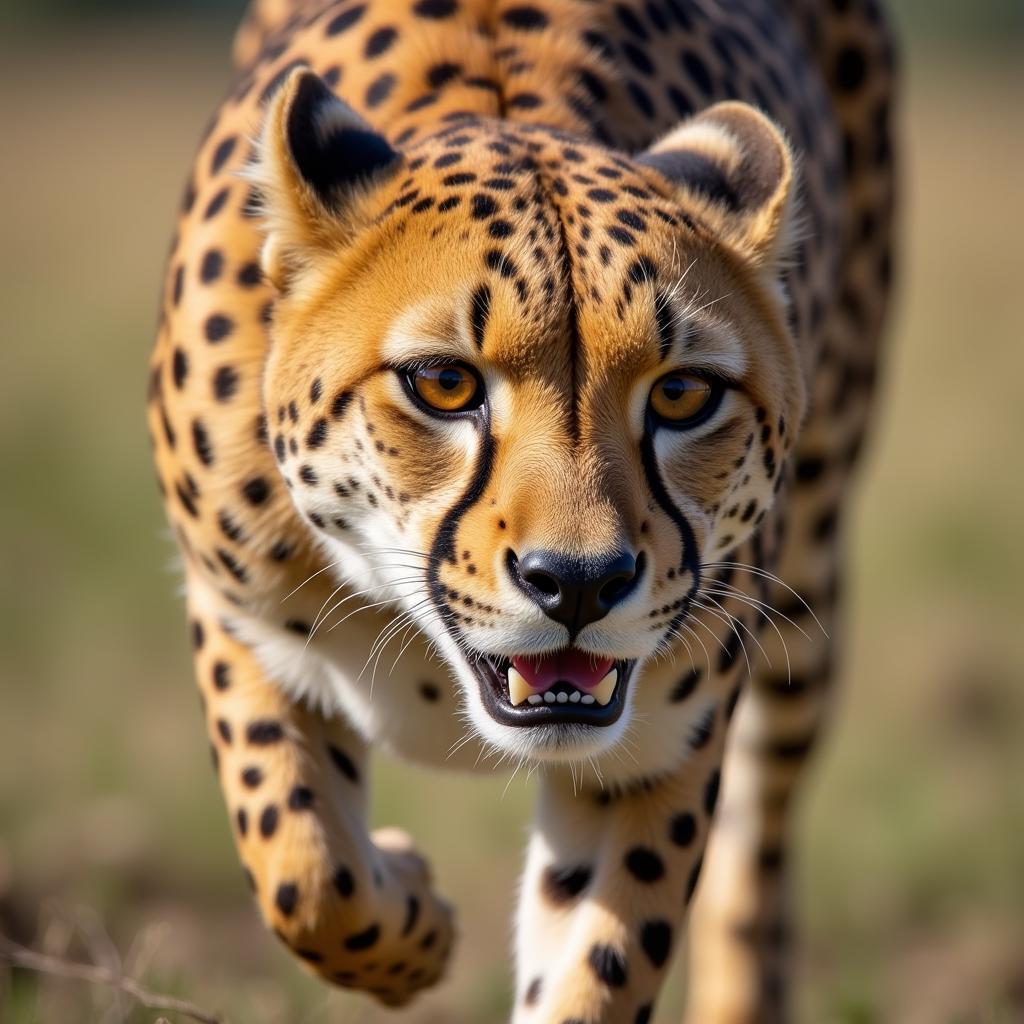The Thrilling Chase: Understanding the African Cheetah Chasing Its Prey
The African Cheetah Chasing its prey is one of nature’s most spectacular sights. This incredible burst of speed and agility showcases the cheetah’s remarkable adaptations, honed over millennia for survival on the African savanna. We’ll delve into the science behind this awe-inspiring hunt, exploring the cheetah’s strategies, the challenges it faces, and the critical role it plays in the ecosystem.
The Science of Speed: How Does an African Cheetah Chase?
Cheetahs are built for speed. Their lightweight frame, flexible spine, and specialized respiratory system allow them to accelerate from 0 to 60 mph in just three seconds. Their non-retractable claws act like cleats, providing extra grip during high-speed turns. But speed isn’t everything. A successful african cheetah chasing sequence requires precision and strategy. The cheetah carefully stalks its prey, using its spotted coat as camouflage in the tall grasses. Once within striking distance, the chase is on!
After the initial burst of speed, the cheetah uses its long tail as a rudder, making sharp turns to keep up with the evasive maneuvers of its prey, often gazelles or impalas. This intense chase is a test of endurance for both predator and prey.
Challenges Faced by the African Cheetah While Chasing
While the cheetah is a formidable hunter, it faces numerous challenges. Larger predators, such as lions and hyenas, often steal their kills. Habitat loss and human encroachment further restrict their hunting grounds. Additionally, the cheetah’s specialized diet requires access to a healthy prey population, which can be affected by environmental factors. Conservation efforts are crucial to ensuring the survival of this magnificent animal.
The Cheetah’s Role in the African Ecosystem
The african cheetah chasing its prey plays a vital role in maintaining the balance of the African ecosystem. By controlling prey populations, they prevent overgrazing and ensure the health of the savanna grasslands. Furthermore, their presence influences the behavior and distribution of other animals within their habitat.
Did you know that you can find a fascinating list of African cats here: african cats list? Understanding the diversity of these feline predators helps us appreciate the unique adaptations of the cheetah.
What Makes the African Cheetah’s Chase Unique?
The cheetah’s chase is unique because of its incredible speed. No other land animal can match the cheetah’s acceleration and top speed. This specialization allows it to hunt prey that other predators cannot catch. However, this speed comes at a cost. The cheetah’s slender build makes it vulnerable to injuries and competition from larger predators.
You might also be interested in learning more about the African Savannah cat: african savannah cat. This domestic breed retains some of the wild beauty and grace of its African ancestors.
How Does the Cheetah’s Chase Impact its Prey?
The constant threat of african cheetah chasing forces prey animals like gazelles to evolve strategies for survival. Their agility and speed are honed by the pressure of predation, contributing to the ongoing evolutionary arms race between predator and prey. This dynamic interplay shapes the biodiversity and resilience of the African savanna. Looking for more information on African cheetahs for kids? Check out this helpful resource: african cheetah facts for kids.
 Cheetah Employing Chasing Strategy
Cheetah Employing Chasing Strategy
“The cheetah’s chase is a testament to the power of natural selection,” says Dr. Anika Moosa, a wildlife biologist specializing in African predator-prey dynamics. “It’s a finely tuned dance of life and death, played out on the vast stage of the African savanna.”
Conclusion: The Future of the African Cheetah Chase
The african cheetah chasing its prey is a breathtaking display of natural selection in action. Protecting this iconic predator and its habitat is essential for preserving the delicate balance of the African ecosystem. By understanding the cheetah’s unique adaptations and the challenges it faces, we can work towards a future where this thrilling chase continues to inspire awe and wonder for generations to come. If you’re interested in exploring more about African big cats, take a look at this link: african big puss.
FAQ
- What is the top speed of a cheetah? (A cheetah can reach speeds up to 70 mph.)
- What do cheetahs eat? (Cheetahs primarily hunt gazelles, impalas, and other small to medium-sized mammals.)
- Why are cheetahs endangered? (Cheetahs are endangered due to habitat loss, human-wildlife conflict, and the illegal wildlife trade.)
- How long does a cheetah chase last? (A cheetah chase typically lasts only a few minutes due to the intense energy expenditure involved.)
- Where do cheetahs live? (Cheetahs are found primarily in Africa, with a small population in Iran.)
- How do cheetahs hunt? (Cheetahs hunt by stalking their prey and then using their incredible speed to chase it down.)
- What are the cheetah’s main predators? (Cheetahs are often preyed upon by lions, hyenas, and leopards, especially when young or injured.)
Common Scenarios
-
Scenario 1: A cheetah spots a group of gazelles grazing in the distance. It carefully stalks its prey, using the tall grass as cover. When the time is right, it launches into a high-speed chase, its body a blur of motion.
-
Scenario 2: A cheetah has successfully hunted a gazelle. However, a lion appears and steals its kill. The cheetah is left hungry and frustrated, highlighting the challenges it faces in the wild.
Further Exploration
You might also be interested in learning about how to download a documentary about African cats: african cats torrent download.
Need support? Contact us 24/7:
Phone: +255768904061
Email: kaka.mag@gmail.com
Address: Mbarali DC Mawindi, Kangaga, Tanzania.

